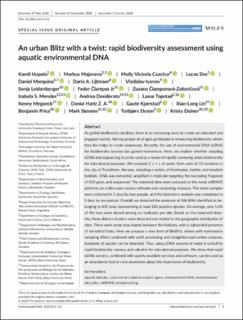| dc.contributor.author | Hupało, Kamil | |
| dc.contributor.author | Majaneva, Markus | |
| dc.contributor.author | Czachur, Molly Victoria | |
| dc.contributor.author | Sire, Lucas | |
| dc.contributor.author | Marquina, Daniel | |
| dc.contributor.author | Lijtmaer, Darío A. | |
| dc.contributor.author | Ivanov, Vladislav | |
| dc.contributor.author | Leidenberger, Sonja | |
| dc.contributor.author | Čiampor, Fedor | |
| dc.contributor.author | Čiamporová-Zat'ovičová, Zuzana | |
| dc.contributor.author | Mendes, Izabela S. | |
| dc.contributor.author | Desiderato, Andrea | |
| dc.contributor.author | Topstad, Lasse | |
| dc.contributor.author | Meganck, Danial Hariz Z. A. | |
| dc.contributor.author | Kjærstad, Gaute | |
| dc.contributor.author | Lin, Xiaolong | |
| dc.contributor.author | Price, Benjamin | |
| dc.contributor.author | Stevens, Mark | |
| dc.contributor.author | Ekrem, Torbjørn | |
| dc.contributor.author | Deiner, Kristy | |
| dc.date.accessioned | 2021-01-25T13:08:28Z | |
| dc.date.available | 2021-01-25T13:08:28Z | |
| dc.date.created | 2021-01-18T23:15:24Z | |
| dc.date.issued | 2020 | |
| dc.identifier.citation | Environmental DNA. 2020, 3(1), . | en_US |
| dc.identifier.issn | 2637-4943 | |
| dc.identifier.uri | https://hdl.handle.net/11250/2724570 | |
| dc.description.abstract | As global biodiversity declines, there is an increasing need to create an educated and engaged society. Having people of all ages participate in measuring biodiversity where they live helps to create awareness. Recently, the use of environmental DNA (eDNA) for biodiversity surveys has gained momentum. Here, we explore whether sampling eDNA and sequencing it can be used as a means of rapidly surveying urban biodiversity for educational purposes. We sampled 2 × 1 L of water from each of 15 locations in the city of Trondheim, Norway, including a variety of freshwater, marine, and brackish habitats. DNA was extracted, amplified in triplicate targeting the barcoding fragment of COI gene, and sequenced. The obtained data were analyzed on the novel mBRAVE platform, an online open‐access software and computing resource. The water samples were collected in 2 days by two people, and the laboratory analysis was completed in 5 days by one person. Overall, we detected the presence of 506 BINs identified as belonging to 435 taxa, representing at least 265 putative species. On average, only 5.4% of the taxa were shared among six replicates per site. Based on the observed diversity, three distinct clusters were detected and related to the geographic distribution of sites. There were some taxa shared between the habitats, with a substantial presence of terrestrial biota. Here we propose a new form of BioBlitz, where with noninvasive sampling effort combined with swift processing and straightforward online analyses, hundreds of species can be detected. Thus, using eDNA analysis of water is useful for rapid biodiversity surveys and valuable for educational purposes. We show that rapid eDNA surveys, combined with openly available services and software, can be used as an educational tool to raise awareness about the importance of biodiversity. | en_US |
| dc.language.iso | eng | en_US |
| dc.publisher | John Wiley & Sons Ltd. | en_US |
| dc.relation.uri | https://onlinelibrary.wiley.com/doi/10.1002/edn3.152 | |
| dc.rights | Navngivelse 4.0 Internasjonal | * |
| dc.rights.uri | http://creativecommons.org/licenses/by/4.0/deed.no | * |
| dc.title | An urban Blitz with a twist: rapid biodiversity assessment using aquatic environmental DNA | en_US |
| dc.type | Peer reviewed | en_US |
| dc.type | Journal article | en_US |
| dc.description.version | publishedVersion | en_US |
| dc.source.volume | 3 | en_US |
| dc.source.journal | Environmental DNA | en_US |
| dc.source.issue | 1 | en_US |
| dc.identifier.doi | 10.1002/edn3.152 | |
| dc.identifier.cristin | 1873810 | |
| dc.description.localcode | This is an open access article under the terms of the Creative Commons Attribution License, which permits use, distribution and reproduction in any medium, provided the original work is properly cited. | en_US |
| cristin.ispublished | true | |
| cristin.fulltext | original | |
| cristin.qualitycode | 1 | |

